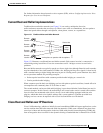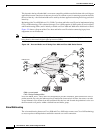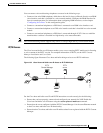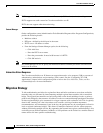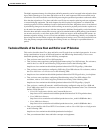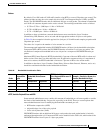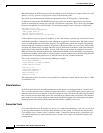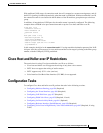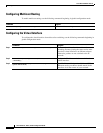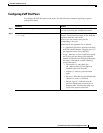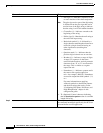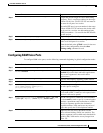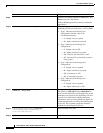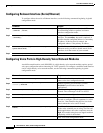
Cisco Hoot and Holler over IP
Cisco Hoot and Holler over IP Restrictions
VC-835
Cisco IOS Voice, Video, and Fax Configuration Guide
With traditional VoIP usages of connection trunk, the call is mapped to a remote router/gateway, and all
the H.323 signaling is handled dynamically when the trunk is established. With hoot and holler over IP,
the connection trunk is associated with the IP address of the IP multicast group that maps to the hoot
group.
In addition, all negotiation of UDP ports for the audio stream is manually configured. The following
example shows an E&M voice port connection trunk set up for Cisco hoot and holler over IP:
voice-port 1/0/0
connection trunk 111
music-threshold -30
operation 4-wire
!
dial-peer voice 1 voip
destination-pattern 111
voice-class permanent 1
session protocol multicast
session target ipv4:237.111.0.0:22222
ip precedence 5
In this example, the digits in the connection trunk 111 string match the destination pattern of the VoIP
dial peer. Also, the session protocol is set to multicast and the session target is pointing to the IPmc group
number, with the UDP port (22222) predefined.
Cisco Hoot and Holler over IP Restrictions
The restrictions for using Cisco hoot and holler over IP are as follows:
• Cisco hoot and holler over IP supports the mixing of only three voice streams.
• IP/TV does not support the mixing of audio streams.
• IP/TV supports only G.711 u-law (mu-law).
• Voice Interface Card Basic Rate Interface (VIC-BRI) is not supported.
Configuration Tasks
To configure Cisco hoot and holler over IP, perform the tasks in the following sections:
• Configuring Multicast Routing, page 836 (Required)
• Configuring the Virtual Interface, page 836 (Required)
• Configuring VoIP Dial Peers, page 837 (Required)
• Configuring E&M Voice Ports, page 839 (Required, if used)
• Configuring for Receive Only Mode, page 841 (Optional)
• Configuring Relevant Interface (Serial/Ethernet), page 842 (Required)
• Configuring Voice Ports in High-Density Voice Network Modules, page 842 (Required, if using
T1/E1)



